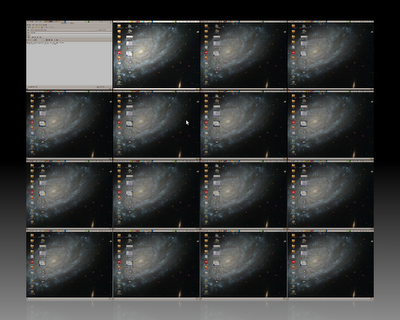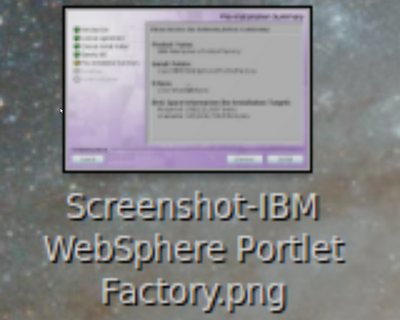Wednesday, 24 February 2010
WebSphere Portal Search Engine is generating the wrong URLs for Web Content Management (WCM) content
Before the upgrade to version 6.1.5/6.1.0.3, content links are shown as: http://<hostname>:<port>/wps/wcm/myconnect/Web_Content/Help/Website/Messages/Send+New+Message#
This /wps/mypoc/ is not recognized
Tuesday, 23 February 2010
Lotus Connections: Troubleshooting ...
Monday, 22 February 2010
Interesting problem with Sametime Unified Telephony under Lotus Notes 8.5.1 FP1 on Apple Mac OSX
Friday, 19 February 2010
Steps to configure Portal v 6.1.x with SQLServer 2005 property extension database
Wednesday, 17 February 2010
Configuring single sign-on for IBM Lotus Connections in the Kerberos environment
IBM Support Tools portlet for Lotus WCM
This portlet includes tools to view the JCR repository for WCM content, run an xpath query and view results, and directly execute various support jsps. These tools are commonly provided by support on a case to case basis to gather information specific to customer environment and content. With this portlet installed on the WCM system, it will help expedite the troubleshooting process.
The portlet is available for V6.0.1.X and V6.1.X of WebSphere Portal and can only be used on Portals that have WCM installed on them.
Thursday, 11 February 2010
JDBC weirdness with WebSphere Application Server 6.1 ...
The SystemOut.log showed a series of database-related SQL errors, which indicated that WAS was not able to correctly authenticate against the back-end DB2 database.
I did the normal thing of logging into the DB2 server and running the commands: -
db2cmd
db2 connect to blogs user lcuser using passw0rd
which validated that the password was correct.
I then logged into the WAS admin console and navigated to Resources -> JDBC -> Data sources, selected the blogs JDBC datasource and clicked 'Test Connection'.
This failed with
java.sql.SQLException: ... Connection authorization failure occurred. Reason: Security mechanism not supported. ERRORCODE=-4214, SQLSTATE=28000DSRA0010E: SQL State = 28000, Error Code = -4214
I then navigated into Security -> Secure administration, applications, and infrastructure -> Java Authentication and Authorization -> J2C authentication data and re-keyed the password for the blogsJAASAuth alias, using the SAME password that I'd used earlier.
Having done this, the 'Test Connection' continued to fail.
Before actually tearing ALL my hair out, I followed the advice of my mentor and yogi, Mr Stephen Hardison Esquire, and restarted the entire WAS infrastructure - clusters ( 3x ), node agent and deployment manager. However, ps auxw still showed that WebSphere JVMs were running, so I killed them with kill -9.
Having then restarted the deployment manager and node agent, I was able to SUCCESSFULLY test the JDBC connection and, when I restarted the clusters, Blogs came back up nicely.
The moral of the story - there's a possibility that WAS ( at least 6.1.0.23 ) somehow "caches" JDBC/JAAS passwords. If in doubt, bounce things, and see what happens ...
Remember, kids, YOUR MILEAGE MAY VARY
Zooming around in Ubuntu
This includes the ability to be able to zoom in and out of the virtual desktops, in a manner similar to that used in Spaces and Expose on the Mac.
For me, with a UK keyboard on a Thinkpad T60p, the magic keystroke is, by default, is [Windows] + [E], also known as [Super][E].
This zooms OUT like this: -
I can then select the required desktop, and hit the right-hand mouse button ( button 2 ) to zoom back in to the chosen one.
However, it gets better.
Compiz also includes the ability to zoom in: -
Again, for me, this is [Windows] + [Button4] which translates to the middle mouse button of the trackpoint on the Thinkpad keyboard.
Having done this, I wasn't sure how to zoom back out, and ended up struggling to restore my desktop.
Thankfully, a quick Sametime chat with my Hursley colleagues http://twitter.com/robhodges and http://twitter.com/spradders managed to save the day.
Having zoomed IN, the trick is to use [Windows] + [E] to return to the many desktops view, and then hit [Esc].
So, in conclusion, here's the magic keystrokes: -
Show MANY desktops [Windows] + [E]
Go to a desktop Select and hit [button2] - right-hand mouse button
Zoom in [Windows] + [button3] - middle mouse button ( on Trackpad )
Zoom out [Windows] + [E] + [Esc]
When Two Worlds Collide - IBM WebSphere on Ubuntu
***Caveat***
This is almost certainly NOT NOT NOT supported by IBM, so be warned :-)
The initial installation of WebSphere Portal Express was troublesome, in that the installer kept failing, with the error: -
/opt/IBM/WebSphere/PortalExpress/AppServer/bin/wsadmin.sh: 116: Bad substitution
which baffled me, until I read Graham Buckell's excellent blog posting here: -
http://www.torkwrench.com/2009/05/04/getting-websphere-portal-to-install-on-ubuntu/
which documents how to change the default shell from dash to bash e.g.
cd /bin
unlink sh
ln -s /bin/bash sh
At this point, I kicked myself because I'd had a similar problem with Tivoli Directory Integrator on Karmic, which I fixed and blogged about a while back: -
http://www.davehay.f2s.com/2009/12/shelling-out-on-ubuntu-910-karmic-koala.html
http://www.eclipse.org/downloads/download.php?file=/technology/epp/downloads/release/ganymede/SR2/eclipse-jee-ganymede-SR2-linux-gtk.tar.gz
Once I "cracked" this, I was off and running - only to run into a wall with WebSphere Portlet Factory Designer 6.1.5.
Again, the "Blogosphere" came to my rescue, with a pair of excellent articles from Ben: -
http://benfletcher.wordpress.com/2010/01/02/websphere-portlet-factory-6-1-5-on-64-bit-ubuntu-9-10/
http://benfletcher.wordpress.com/2010/01/03/iwidgets-on-ibm-mashup-center-via-websphere-portlet-factory
In essence, I downloaded and installed a nice shiny new copy of Eclipse 3.4.2 ( eclipse-jee-ganymede-SR2-linux-gtk.tar.gz ) from here: -
http://www.eclipse.org/downloads/download.php?file=/technology/epp/downloads/release/ganymede/SR2/eclipse-jee-ganymede-SR2-linux-gtk.tar.gz
and expanded the TAR file ( tar xvzf ) to /usr/share ( thus creating /usr/share/eclipse ).
I then created a symbolic link to the Eclipse binary: -
cd /usr/bin
ln -s /usr/share/eclipse/eclipse .
I then ran the WebSphere Portlet Factory Designer installer, and dropped the WPF binaries into /opt/IBM/WebSphere/PortletFactory/Designer, and "told" the installer where to find Eclipse ( /usr/share/eclipse ).
However, it may have been my "faffing about" but Eclipse still didn't include the WPFD elements when I started it, so I had to perform some more "magic", by clicking Help -> Software Updates -> Add Site and add /opt/IBM/WebSphere/PortletFactory/Designer/eclipse as an installation location.
I'll add some screenshots of this later, but this allowed me to add the WPF features into Eclipse and, after a restart ( of Eclipse, not Ubuntu ! ), I was able to create a WPF project.
However, it was Ben's extra secrets that helped make this totally work: -
a) Adding the line: -
-Dorg.eclipse.swt.browser.XULRunnerPath=/usr/lib/xulrunner
to: -
/usr/share/eclipse/eclipse.ini
to give me: -
-showsplash
org.eclipse.platform
-framework
plugins/org.eclipse.osgi_3.4.3.R34x_v20081215-1030.jar
-vmargs
-Dosgi.requiredJavaVersion=1.5
-Xms40m
-Xmx512m
-XX:MaxPermSize=256m
-Dorg.eclipse.swt.browser.XULRunnerPath=/usr/lib/xulrunner
These effectively set run-time options, and the XULRunner "hack" avoids fatal messages such as: -
java.lang.RuntimeException: Widget disposed too early!
which is a pain.
b) Changing the way that Eclipse launches popup windows to use the older GTK method; this was achieved by "hacking" the environment via a shell script to start Eclipse: -
export GDK_NATIVE_WINDOWS=1
/usr/bin/eclipse
This allows Eclipse to launch windows of its own; without this, you'll find that certain processes will never complete, as the pop-up windows never show up.
So, that's it, we're mostly done.
One thing that did confuse me - I run WebSphere Portal as a root user ( via the sudo su command ), and was running Eclipse as my normal non-root user. This meant that, whilst I could create portlet projects, I couldn't deploy them to WebSphere Portal, and was seeing messages such as: -
creation was not successful for an unknown reason
Once I ran Eclipse as root, all was well.
Footnote: A chap called Curran ( who's based 10 minutes down the road from where I currently sit in Littleton, MA ) has blogged more about Eclipse in Ubuntu here: -
http://lifeofaprogrammergeek.blogspot.com/2008/04/eclipse-java-development-in-ubuntu.html
and has written a script which appears to allow me to start Eclipse as my normal non-root user, but use sudo to allow the Eclipse processes to run as root, which is far more elegant than my approach.
Will try it and report back ...
Wednesday, 10 February 2010
WebSphere Portal and Web Content Management 6.1.5 Information Center highlights
IBM Product Development and Product Support will host a Tech Exchange webcast about WebSphere Portal and Web Content Management (WCM) 6.1.5 Information Center highlights on Wednesday, February 17, 2010, at 10:00 a.m. US EST (3:00 p.m. GMT).
Content
IBM® Product Development and Product Support will host a Tech Exchange webcast about WebSphere Portal and Web Content Management (WCM) 6.1.5 Information Center highlights on Wednesday, February 17, 2010, at 10:00 a.m. US EST (3:00 p.m. GMT).Webcasts are slide presentations by a single presenter followed by Questions and Answers related to the material covered, as time permits.
You can submit a question in advance by posting a new reply to the announcement at http://www.ibm.com/developerworks/forums/thread.jspa?threadID=316304.
Schedule:
Date: Wednesday, February 17, 2010
Time: 10:00 - 11:30 a.m. US EST (3:00 - 4:30 p.m. GMT)
Webcast URL: https://www.lotuslive.com/en/join?schedid=5260580
For more information, please go here: -
http://www-01.ibm.com/support/docview.wss?uid=swg21418576
Tuesday, 9 February 2010
SQL5043N when starting DB2 UDB 9.5 on Windows
In essence, we'd created a new instance owner/admin ID under the Windows OS ( Start > Administrative Tools > Computer Management > Local Users and Groups > Users > Action > New User ) - this user was DB2ADMIN2 and was assigned membership of the DB2ADMNS group.
Having done this, we logged into Windows as this new user ( DB2ADMIN2 ), and created a new database instance: -
db2icrt DB2_2 -s ese -u db2admin2 -r 60010,60013
which assigns a port range of 60010-60013 to the new instance, of type Enterprise Server Edition.
Having done this, we added the line: -
db2c_DB2_2 50001/tcp
to C:\Windows\system32\drivers\etc\services.
This sets up port 50001 as the JDBC listener, which makes sense given that the first instance ( DB2 ) is listening on 50000.
We then attempted to start the instance: -
set DB2INSTANCE=DB2_2
db2 update database manager configuration using SVCENAME db2c_DB2_2
db2set DB2COMM=npipe,tcpip
db2stop
db2start
Sadly, the latter command failed with: -
02/09/2010 17:32:34 0 0 SQL5043N Support for one or more communications protocols failed to start successfully. However, core database manager functionality started successfully.
A quick check with the command: -
netstat -aon | find "5000"
showed that the first instance was listening away happily on 50000, but that the second instance just did not want to start up on 50001.
After much faffing about, my instructor/colleague, Stephen Hardison, asked me to re-edit the C:\Windows\system32\drivers\etc\services file, using Notepad ( of course ), and add an extra Carriage Return (CR/LF) to the end of the file.
Having done this, and saved the file, we ran the commands: -
db2stop
db2start
and, c'est voila, the same netstat command showed that both 50000 *AND* 500001 were listening away merrily.
The moral of the story - don't use Notepad to edit files and ensure that there is an extra CR/LF at the end of the services file.
Simple when you know how :-)
Friday, 5 February 2010
Whitepaper - Driving adoption of Lotus Connections
<snip>
Enterprise social software is gaining practical currency now as analysts' auspicious forecasts begin to be realized with the first wave of early adopters. This new class of software taps informal interactions and relationships among workers with complementary interests, skills, and knowledge, offering new ways to engage the collective intelligence of organizations towards achieving business ends. As such it represents an evolutionary advance in collaboration as a means to higher productivity and competitiveness.
The industry's first integrated suite of enterprise social software, IBM Lotus Connections, became available in June 2007. Featuring five Web 2.0-based components - Profiles, Blogs, Dogear (social bookmarking), Communities, and Activities — Lotus Connections provides a full palette of capabilities that help people find expertise and information and build new relationships based on business needs. Since coming onto the market, sales of this product have continued to be robust. And now there is a growing body of deployment tips and best practices new purchasers can employ to promote steady adoption and productive use of these tools in their own environments.
Thursday, 4 February 2010
Resources for administrators and developers - WebSphere Portal 6.1.5
Creating External Facing Web Sites Using IBM WebSphere Portal
The wiki begins with a brief overview of the differences between internal and external facing Web sites. Then it provides an overview of the factors that contribute to successful Web sites. Next the wiki provides more technical content related to Web Content Management and Web 2.0 considerations. Next a discussion is presented about the various UI frameworks supported by WebSphere Portal and personalization for the user.
This wiki includes an extensive discussion related to search and the integration of search engines. In particular, Section 8 covers site analytics and optimization. The wiki concludes with information about mobile device support. In addition, this wiki includes examples, window captures, and code samples based on various scenarios.
Wednesday, 3 February 2010
Crazy Error: VMware Infrastructure Web Service at "http://localhost:8222/sdk" is not responding
Tuesday, 2 February 2010
IBM WebSphere eXtreme Scale 6 by Anthony Chaves, my closing comments
Monday, 1 February 2010
Using WebSphere Portal documentation offline
The WebSphere Portal 6.1.5 Information Centre is available offline, from this page: -
http://www.ibm.com/developerworks/websphere/zones/portal/proddoc.html
specifically, via this link ( as a ZIP file ).
This ZIP file then references the "...the IBM User Interface Help System built on Eclipse...".
However, when I Google'd for this, I found: -
"...
This technology has graduated.
The IBM User Interface Help System Built on Eclipse framework can be found running help systems within many IBM products. Additionally, the framework is being used to provide information centers for most IBM products. These information centers are available on-line and frequently they are also made available with the product itself to be installed locally.
..."
http://www.alphaworks.ibm.com/tech/iehs
That wasn't a whole lot of help ...
Thankfully, thanks to one of my colleagues ( thanks, Cali ! ) bookmarking this page: -
IBM User Interface Help System Built on Eclipse
https://www14.software.ibm.com/webapp/iwm/web/preLogin.do?source=AW-0M5&S_PKG=0M5〈=en_US&cp=UTF-8
from where one can download the 8 MB plugin.
In conclusion, I'm hoping that a combination of this: -
http://publib.boulder.ibm.com/infocenter/wpdoc/v6r1/topic/com.ibm.wp.ent.doc_v615/com.ibm.wp.ent.doc_v615.zip
and this: -
http://www.eclipse.org/downloads/
and this: -
https://www14.software.ibm.com/webapp/iwm/web/preLogin.do?source=AW-0M5&S_PKG=0M5〈=en_US&cp=UTF-8
will do the job.
More to follow ...
WebSphere Portlet Factory Designer 6.1.5 - The Icon ...
For one of my launchers, for WebSphere Portlet Factory Designer, I was looking for, and failing to find, the appropriate "old skool" Bowstreet Portlet Factory Designer icon.
Thanks to my work colleague, and all round good bloke ( who does a LOT of good work for charity ), Mr Mike "@spradders" Spradbery, I found the icon path to be as follows: -
/opt/IBM/WebSphere/PortletFactory/Designer/eclipse/plugins/com.bowstreet.designer_6.1.5/Builder.gif
so my launcher looks as follows: -
[Desktop Entry]
Version=1.0
Encoding=UTF-8
Name=WebSphere Portlet Factory Designer
Type=Application
Terminal=false
Exec=/root/startWPF.sh
Name[en_US]=WebSphere Portlet Factory Designer
Icon=/opt/IBM/WebSphere/PortletFactory/Designer/eclipse/plugins/com.bowstreet.designer_6.1.5/Builder.gif
Subscribe to Posts [Atom]



